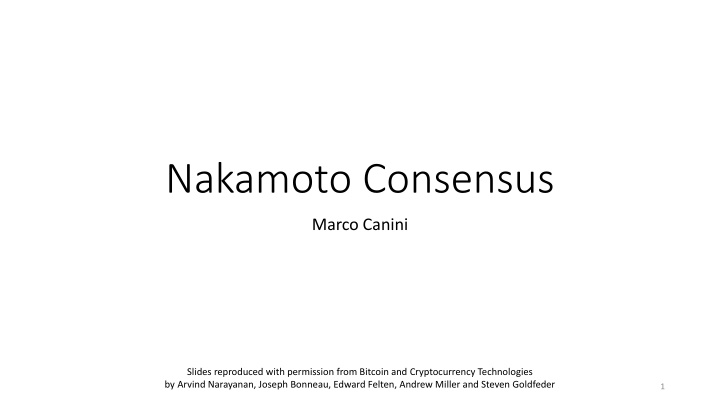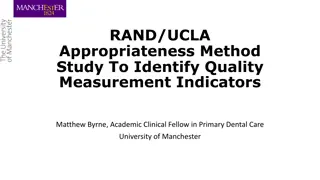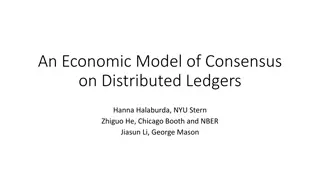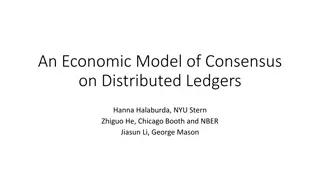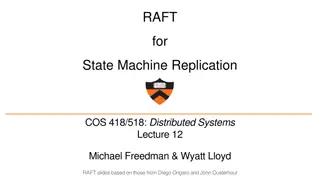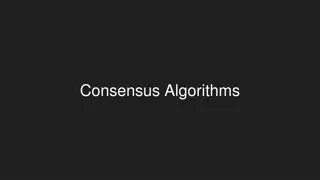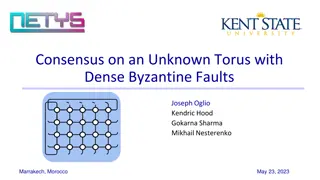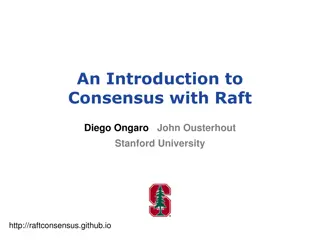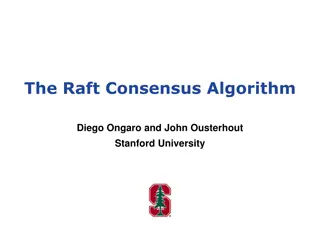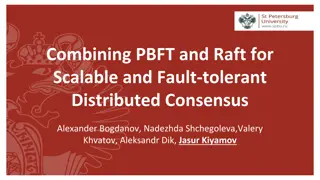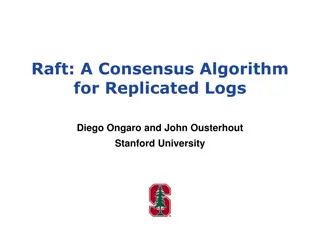Nakamoto Consensus
The fundamental concepts of Nakamoto Consensus as a key feature in digital currency technologies. Delve into the mechanism of creating, transferring, and validating new coins securely within the blockchain network to prevent double-spending attacks and ensure transaction integrity.
Uploaded on Feb 18, 2025 | 0 Views
Download Presentation

Please find below an Image/Link to download the presentation.
The content on the website is provided AS IS for your information and personal use only. It may not be sold, licensed, or shared on other websites without obtaining consent from the author.If you encounter any issues during the download, it is possible that the publisher has removed the file from their server.
You are allowed to download the files provided on this website for personal or commercial use, subject to the condition that they are used lawfully. All files are the property of their respective owners.
The content on the website is provided AS IS for your information and personal use only. It may not be sold, licensed, or shared on other websites without obtaining consent from the author.
E N D
Presentation Transcript
Nakamoto Consensus Marco Canini Slides reproduced with permission from Bitcoin and Cryptocurrency Technologies by Arvind Narayanan, Joseph Bonneau, Edward Felten, Andrew Miller and Steven Goldfeder 1
Goofy can create new coins New coins belong to me. signed by pkGoofy CreateCoin [uniqueCoinID]
A coins owner can spend it. Alice owns it now. signed by pkGoofy Pay to pkAlice : H( ) signed by pkGoofy CreateCoin [uniqueCoinID]
The recipient can pass on the coin again. signed by pkAlice Bob owns it now. Pay to pkBob : H( ) signed by pkGoofy Pay to pkAlice : H( ) signed by pkGoofy CreateCoin [uniqueCoinID]
double-spending attack signed by pkAlice signed by pkAlice Pay to pkBob : H( ) Pay to pkChuck : H( ) signed by pkGoofy Pay to pkAlice : H( ) signed by pkGoofy CreateCoin [uniqueCoinID]
double-spending attack the main design challenge in digital currency
Scrooge publishes a history of all transactions (a block chain, signed by Scrooge) H( ) prev: H( ) transID: 71 prev: H( ) transID: 72 prev: H( ) transID: 73 trans trans trans optimization: put multiple transactions in the same block
CreateCoins transaction creates new coins Valid, because I said so. transID: 73 type:CreateCoins coins created num value recipient coinID 73(0) coinID 73(1) coinID 73(2) 0 3.2 0x... 1 1.4 0x... 2 7.1 0x...
PayCoins transaction consumes (and destroys) some coins, and creates new coins of the same total value transID: 73 type:PayCoins consumed coinIDs: 68(1), 42(0), 72(3) Valid if: -- consumed coins valid, -- not already consumed, -- total value out = total value in, and -- signed by owners of all consumed coins coins created num value recipient 0 3.2 0x... 1 1.4 0x... 2 7.1 0x... signatures
Immutable coins Coins can t be transferred, subdivided, or combined. But: you can get the same effect by using transactions to subdivide: create new trans consume your coin pay out two new coins to yourself
Dont worry, Im honest. Crucial question: Can we descroogify the currency, and operate without any central, trusted party?
Aspects of decentralization in Bitcoin 1. Who maintains the ledger? 2. Who has authority over which transactions are valid? 3. Who creates new bitcoins? 4. Who determines how the rules of the system change? 5. How do bitcoins acquire exchange value? Beyond the protocol: exchanges, wallet software, service providers...
Aspects of decentralization in Bitcoin Peer-to-peer network: open to anyone, low barrier to entry Mining: open to anyone, but inevitable concentration of power often seen as undesirable Updates to software: core developers trusted by community, have great power
Some things Bitcoin does differently Introduces incentives Possible only because it s a currency! Embraces randomness Does away with the notion of a specific end-point Consensus happens over long time scales about 1 hour
Key idea: implicit consensus In each round, random node is picked This node proposes the next block in the chain Other nodes implicitly accept/reject this block by either extending it or ignoring it and extending chain from earlier block Every block contains hash of the block it extends
Consensus algorithm (simplified) New transactions are broadcast to all nodes Each node collects new transactions into a block In each round a random node gets to broadcast its block Other nodes accept the block only if all transactions in it are valid (unspent, valid signatures) Nodes express their acceptance of the block by including its hash in the next block they create 1. 2. 3. 4. 5. 20
What can a malicious node do? Double- spending attack signed by A CA B Pay to pkB : H( ) signed by A CA A Pay to pkA : H( ) Honest nodes will extend the longest valid branch 21
From Bob the merchants point of view 1 confirmation 3 confirmations CA B Double-spend probability decreases exponentially with # of confirmations double-spend attempt CA A Hear about CA B transaction 0 confirmations Most common heuristic: 6 confirmations 22
Assumption of honesty is problematic Can we give nodes incentives for behaving honestly? Can we reward nodes that created these blocks? Can we penalize the node that created this block? Everything so far is just a distributed consensus protocol But now we utilize the fact that the currency has value
Incentive 1: block reward Creator of block gets to include special coin-creation transaction in the block choose recipient address of this transaction Value is fixed: currently 25 BTC, halves every 4 years Block creator gets to collect the reward only if the block ends up on long-term consensus branch!
Theres a finite supply of bitcoins Total supply: 21 million Total bitcoins in circulation Block reward is how new bitcoins are created First inflection point: reward halved from 50BTC to 25BTC Runs out in 2040. No new bitcoins unless rules change Year
Incentive 2: transaction fees Creator of transaction can choose to make output value less than input value Remainder is a transaction fee and goes to block creator Purely voluntary, like a tip
Remaining problems 1. How to pick a random node? 1. How to avoid a free-for-all due to rewards? 1. How to prevent Sybil attacks?
Proof of work To approximate selecting a random node: select nodes in proportion to a resource that no one can monopolize (we hope) In proportion to computing power: proof-of-work In proportion to ownership: proof-of-stake
Equivalent views of proof of work 1. Select nodes in proportion to computing power 1. Let nodes compete for right to create block 1. Make it moderately hard to create new identities
Hash puzzles nonce prev_h Tx Tx To create block, find nonce s.t. H(nonce prev_hash tx tx) is very small Output space of hash Target space If hash function is secure: only way to succeed is to try enough nonces until you get lucky
PoW property 1: difficult to compute As of Aug 2014: about 1020 hashes/block Only some nodes bother to compete miners
PoW property 2: parameterizable cost Nodes automatically re-calculate the target every two weeks Goal: average time between blocks = 10 minutes Prob (Alice wins next block) = fraction of global hash power she controls
Key security assumption Attacks infeasible if majority of miners weighted by hash power follow the protocol
Solving hash puzzles is probabilistic 10 minutes Probability density Time to next block (entire network)
PoW property 3: trivial to verify Nonce must be published as part of block Other miners simply verify that H(nonce prev_hash tx tx) < target
Mining economics If mining reward (block reward + Tx fees) hardware + electricity cost Profit > Complications: fixed vs. variable costs reward depends on global hash rate
Bitcoin is bootstrapped security of block chain health of mining ecosystem value of currency
What can a 51% attacker do? Steal coins from existing address? Suppress some transactions? From the block chain From the P2P network Change the block reward? Destroy confidence in Bitcoin?
